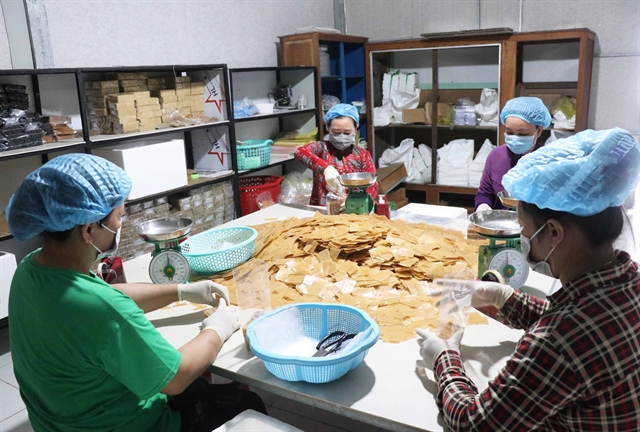 Economy
Economy
.jpg)
 |
| A shrimp exporting business in Cà Mau Province. The province's focus on collective economy has been driving its agricultural development. — VNA/VNS Photo |
CÀ MAU — The collective economy, with cooperatives at its heart, is emerging as a key driver of agricultural and rural development in Cà Mau Province.
By fostering cooperation among farmers and supporting innovation, the province is gradually turning this model into a pillar of sustainable, modern agriculture.
Living in a land rich in aquatic resources, Lê Minh Sang from Đầm Dơi Commune has built his livelihood around tôm đất – the region’s signature small native shrimp.
In 2019, he founded Sông Đầm Cooperative, specialising in dried shrimp.
By applying solar-powered drying technology and modern processing methods, the cooperative created Sông Đầm dried shrimp, now rated 4-star under the One Commune One Product (OCOP) programme and sold in supermarkets in HCM City, Hà Nội, and Cần Thơ City.
“Our shrimp are dried with solar energy, without preservatives, so they keep their natural sweetness and aroma,” Sang said.
His cooperative employs more than 10 locals earning VNĐ5–6 million (US$200–240) a month, while helping preserve the traditional craft.
According to the People’s Committee of Đầm Dơi Commune, Sông Đầm’s success shows how collective models can unlock local potential.
After receiving its OCOP recognition, the cooperative’s brand gained strong market trust and helped reduce poverty sustainably.
Other cooperatives have also found new momentum. Vĩnh Thành Cooperative in Vĩnh Hậu Commune doubled its orders after its OCOP certification, while Ông Muộn Agricultural and Aquatic Service Cooperative, led by Nguyễn Văn Tiếp, has marketed 4-star OCOP rice produced under clean standards.
“Working collectively helps farmers plan production and build brands,” Tiếp said.
Nguyễn Văn Vũ, chairman of the Cà Mau Cooperative Alliance, said that the province supports cooperatives through funding and technical guidance to develop OCOP products.
“This approach brings dual benefits – expanding production and attracting more members,” he added.
Currently, Cà Mau has 612 cooperatives with over 35,000 members, 80 per cent of whom work in agriculture.
In addition, there are 1,498 cooperative groups and five cooperative unions providing input services and linking production with markets in key sectors like rice, shrimp, and salt.
The province now counts 343 OCOP products, including 129 rated three stars or higher, owned by 53 cooperatives.
Many have embraced online platforms such as Postmart, Voso, Shopee, and Facebook, expanding sales and reaching new customers.
Building a sustainable foundation
Experts warn that agriculture remains highly vulnerable to market fluctuations, diseases, and climate change.
Farmers still face the dilemma of “bumper crops but low prices.” The lack of strong production linkages and unstable contracts between farmers and businesses limits long-term growth.
“Few cooperatives are operating effectively along the value chain or applying high technology,” said Nguyễn Văn Vũ.
“We must strengthen supervision, provide timely support, and train capable managers to improve market understanding and governance.”
Trần Minh Hải, vice rector of the School of Public Policy and Rural Development, emphasised that cooperatives should expand membership, rejuvenate management, and attract enterprises to strengthen brand value and market access.
To enhance resilience, Cà Mau is implementing a Collective Economy Development Plan for 2025–2030, linked with national programmes on development of new-style rural areas and OCOP.
The goal is to make the collective economy a cornerstone of modern, sustainable agriculture that adapts to climate change.
According to Phạm Văn Mười, deputy director of the provincial Department of Agriculture and Environment, Cà Mau is reorganising high-tech aquaculture zones, including 10,000 hectares of intensive shrimp farming and 115,000 hectares of shrimp–rice farming, forming concentrated production areas meeting both domestic and international standards.
The province targets a 5.5 per cent annual agricultural–forestry–fishery growth rate and overall GRDP growth of 8 per cent or higher by 2025.
Meanwhile, many farmers are adopting smart farming models, such as greenhouse melon cultivation, Israeli drip irrigation, and super-intensive shrimp farming.
These innovations reduce costs, raise productivity, and ensure consistent quality for processing and export.
With strong government backing and the dynamism of local cooperatives, Cà Mau’s collective economy is steadily proving its vital role. — VNS
.jpg)



